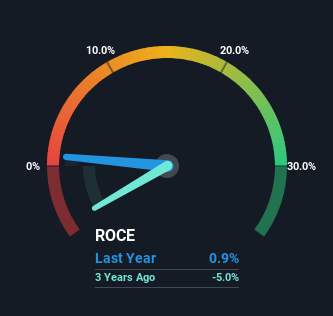- South Korea
- /
- Entertainment
- /
- KOSDAQ:A408900
Returns On Capital Signal Tricky Times Ahead For Studio Mir (KOSDAQ:408900)
Did you know there are some financial metrics that can provide clues of a potential multi-bagger? Typically, we'll want to notice a trend of growing return on capital employed (ROCE) and alongside that, an expanding base of capital employed. Basically this means that a company has profitable initiatives that it can continue to reinvest in, which is a trait of a compounding machine. Although, when we looked at Studio Mir (KOSDAQ:408900), it didn't seem to tick all of these boxes.
Understanding Return On Capital Employed (ROCE)
For those who don't know, ROCE is a measure of a company's yearly pre-tax profit (its return), relative to the capital employed in the business. The formula for this calculation on Studio Mir is:
Return on Capital Employed = Earnings Before Interest and Tax (EBIT) ÷ (Total Assets - Current Liabilities)
0.0086 = ₩350m ÷ (₩44b - ₩3.9b) (Based on the trailing twelve months to June 2024).
Therefore, Studio Mir has an ROCE of 0.9%. Ultimately, that's a low return and it under-performs the Entertainment industry average of 7.0%.
View our latest analysis for Studio Mir

Historical performance is a great place to start when researching a stock so above you can see the gauge for Studio Mir's ROCE against it's prior returns. If you're interested in investigating Studio Mir's past further, check out this free graph covering Studio Mir's past earnings, revenue and cash flow.
What Does the ROCE Trend For Studio Mir Tell Us?
In terms of Studio Mir's historical ROCE movements, the trend isn't fantastic. Around five years ago the returns on capital were 7.2%, but since then they've fallen to 0.9%. And considering revenue has dropped while employing more capital, we'd be cautious. If this were to continue, you might be looking at a company that is trying to reinvest for growth but is actually losing market share since sales haven't increased.
On a side note, Studio Mir has done well to pay down its current liabilities to 8.9% of total assets. That could partly explain why the ROCE has dropped. Effectively this means their suppliers or short-term creditors are funding less of the business, which reduces some elements of risk. Since the business is basically funding more of its operations with it's own money, you could argue this has made the business less efficient at generating ROCE.
Our Take On Studio Mir's ROCE
We're a bit apprehensive about Studio Mir because despite more capital being deployed in the business, returns on that capital and sales have both fallen. Investors must expect better things on the horizon though because the stock has risen 3.6% in the last year. Regardless, we don't like the trends as they are and if they persist, we think you might find better investments elsewhere.
Studio Mir does have some risks though, and we've spotted 2 warning signs for Studio Mir that you might be interested in.
For those who like to invest in solid companies, check out this free list of companies with solid balance sheets and high returns on equity.
New: Manage All Your Stock Portfolios in One Place
We've created the ultimate portfolio companion for stock investors, and it's free.
• Connect an unlimited number of Portfolios and see your total in one currency
• Be alerted to new Warning Signs or Risks via email or mobile
• Track the Fair Value of your stocks
Have feedback on this article? Concerned about the content? Get in touch with us directly. Alternatively, email editorial-team (at) simplywallst.com.
This article by Simply Wall St is general in nature. We provide commentary based on historical data and analyst forecasts only using an unbiased methodology and our articles are not intended to be financial advice. It does not constitute a recommendation to buy or sell any stock, and does not take account of your objectives, or your financial situation. We aim to bring you long-term focused analysis driven by fundamental data. Note that our analysis may not factor in the latest price-sensitive company announcements or qualitative material. Simply Wall St has no position in any stocks mentioned.
About KOSDAQ:A408900
Flawless balance sheet with very low risk.
Market Insights
Community Narratives


Recently Updated Narratives


MINISO's fair value is projected at 26.69 with an anticipated PE ratio shift of 20x


The Quiet Giant That Became AI’s Power Grid


Nova Ljubljanska Banka d.d will expect a 11.2% revenue boost driving future growth
Popular Narratives


The company that turned a verb into a global necessity and basically runs the modern internet, digital ads, smartphones, maps, and AI.


MicroVision will explode future revenue by 380.37% with a vision towards success



